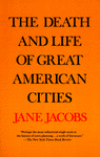Out on the Border

In 1961, while I was in high school (sigh), Vintage published one of the great books of the twentieth century, Jane Jacobs’ The Death and Life of Great American Cities. I read it for the first time a few years later, and there is a sense in which I am still recovering from the experience. Obituaries published after Jacobs’s recent death (in April, 2006) testified to the book’s impact on the generation that grew up in what might be called the “long” 1950s, which stretched well into the ‘60s, but then was exploded by the strange brew of Vietnam, urban rioting, and counter-culture romanticism.
The Death and Life helped to explain some of what was happening, or about to happen, in America’s cities—the urban rioting, at least. Jacobs argued that the prevailing wisdom about urban form and function had been concocted out of an intellectual stew that featured three principal ingredients: the celebrated White City of the 1893 World’s Columbian Exposition in Chicago; Ebenezer Howard’s Garden City concept of a few years later; and the Skyscrapers-in-a-Park ideology promoted after the Great War by Le Corbusier and other International Style visionaries. Jacobs coined an epithet, Radiant Garden City Beautiful, that she used to lampoon all three of them at once.
The Death and Life opens with the following sentence: “This book is an attack on current city planning and rebuilding.” She then recalls a visit to Boston’s North End. “The streets were alive with children playing, people shopping, people strolling, people talking.” The North End struck her as “the healthiest place in the city,” though when she reported that to her city planner friends, they insisted that it was a miserable and dangerous place, “a terrible slum.”
The planners thought that the North End, in all its higgledy-piggledy unplanned glory, needed to be rebuilt along Radiant Garden City Beautiful lines, and there was no talking them out of that, just as there was no dissuading “urban renewal” authorities from tucking into the federal trough to build high-rise public housing projects and expressways (think Robert Moses), or private developers from tearing down buildings just because they happened to be old.
Jacobs’s sweeping indictment of the city planning profession, and of prevailing attitudes about the dynamics of “slumming” and “unslumming,” was so radical that its lessons were instantly rejected by the smart set, most famously by Lewis Mumford, who ridiculed her for prescribing “home remedies for urban cancer.” Jacobs offended people by expressing her ideas in deliberately provocative prose: density is good; zoning is bad; old buildings are inherently valuable; parks and playgrounds are dangerous; children should play in the street. And yet anyone who suspended disbelief and actually read the book was shaken to the core. Page after sparkling page, chapter after relentless chapter, Jacobs stalked her rats and then set upon them with the jaws of an Airedale terrier.
Those of us who internalized Jacobs’ message will find that certain passages or concepts can come back vividly and unexpectedly back to life—when driving through the kind of area that she called a Great Blight of Dullness, for example, or walking through a neighborhood enlivened by mixed primary uses and the kind of natural surveillance systems that she termed “streets with eyes.”
I recently had occasion to recall Jacobs’s memorable treatment of the subject of “border vacuums.” Not having the book in front of me, I will do the best I can to summarize it from memory. Basically, the concept refers to the fact that some urban districts are dominated—not architecturally so much as functionally—by a single over-riding use. The problem, as she explained it, is not so much that single use in itself as the fact that it will try to suppress all other uses. Borrowing from the lexicon of such 1950s narratives as West Side Story, Jacobs liked to refer to these monoliths as “Turf.” Whatever is on the periphery of Turf will morph into barriers and dead ends, “border vacuums." Kevin Lynch called them “edges.”
Jacobs often cited large urban universities and hospitals as examples. Columbia University and the University of Chicago particularly provoked Jacobs’s wrath because of their insatiable appetite for land and their fear that they would be “contaminated” by non-conforming uses. A railroad right-of-way is almost a textbook case. As a swatch of linear, one-dimensional Turf, it will admit of no other uses. Not much can be done to mitigate the baneful effect of railroad tracks on adjoining property because trains do not mix well with other urban activities, except where there are railway stations, which, to the extent that they generate cross-traffic and commercial activity, precisely illustrate Jacobs’s point about the virtues of functional integration.
Jacobs suggested that addressing the problem of “border vacuums” required the fashioning of “seams,” or dovetailing, to effect a gradual transition from monolithic Turf to non-Turf. Sometimes, the best way to do that is by triangulation—that is, by introducing a third function to the mix. The goal is to create an area rendered lively and safe by a complex pattern of use by different kinds of people at different times of the day. Commercial activities in border areas, even on a small scale, such as with street vendors, can often serve to break up the hegemony of large-scale Turf.
The worst possible kind of “border vacuums” arise in places where one monolith directly abuts another. I don't recall whether Jacobs talks about international borders, but there is every reason to think that they would represent notable Turf-on-Turf challenges. The whole point of an international boundary is Turf guarding—to define us and them, in and out, and to prevent insinuation, penetration.
You are no doubt wondering where I am going with this narrative. The answer is that I’m going to Tornio-Haparanda. Come with me in the next post.


0 Comments:
Post a Comment
<< Home